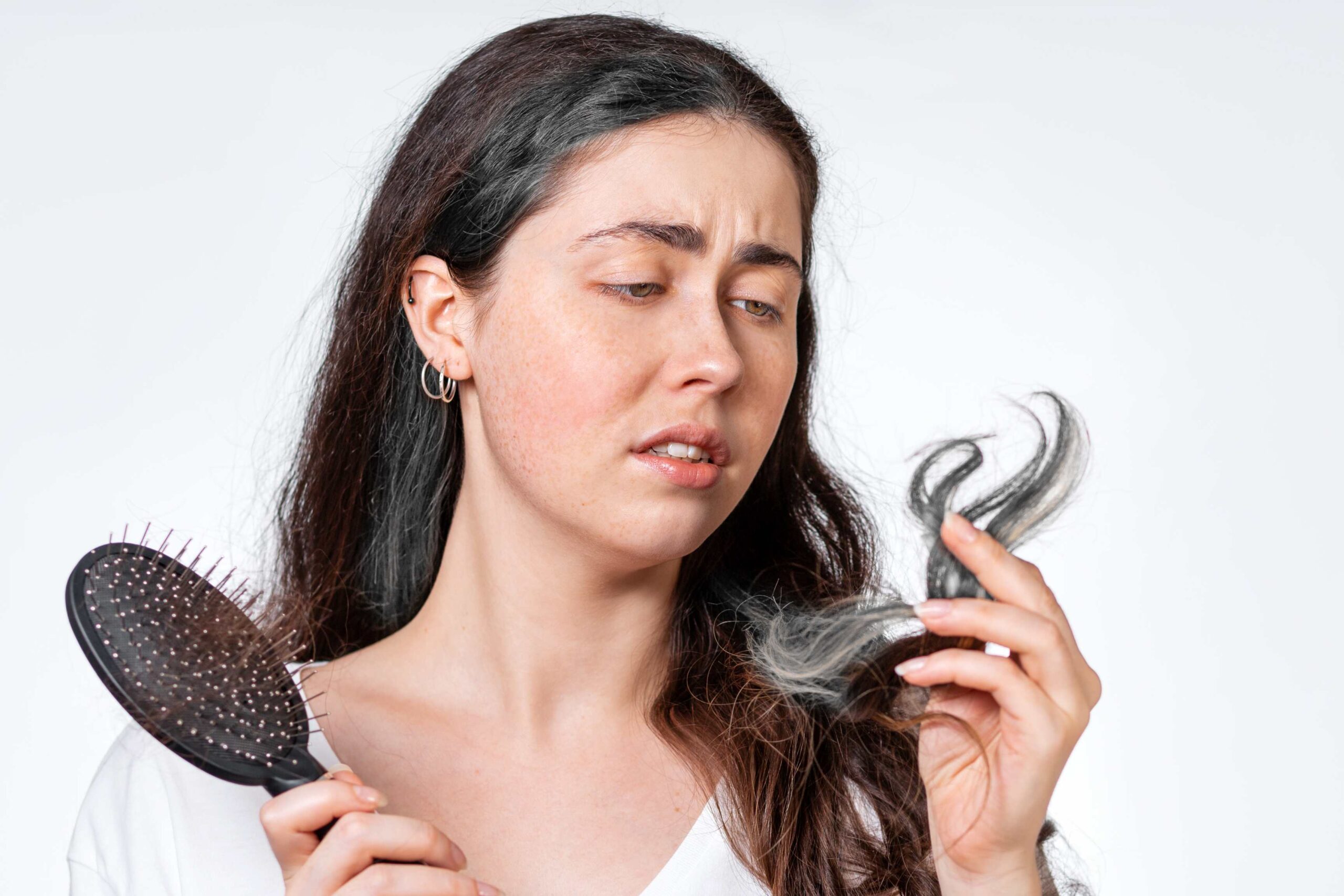Why is my gray hair so dry? As we age, numerous changes occur in our bodies, and our hair is no exception. Gray hair appearing is one of the most visible signs of aging. But why does this hair often feel drier than our youthful locks? Here’s a simplified breakdown.
- Loss of Natural Oils: The scalp contains sebaceous glands that produce sebum, a natural oil. Sebum is what gives our hair a shiny, smooth texture. However, as we grow older, these glands may produce less sebum. The result? Less natural oil on the hair shaft leads to drier hair.
- Hair Structure: Under a microscope, you’d see that each hair strand has an outer layer called the cuticle. Think of it like roof shingles. When we’re younger, these “shingles” lie flat, keeping moisture inside. With age and other factors, the cuticle can lift. When the cuticle is raised, hair loses moisture more easily, leading to dryness. Gray hair often has a more raised cuticle than pigmented hair.
- Pigment Production: Melanin is the pigment that gives our hair its color. As we age, the production of melanin decreases. Not only does this lead to the hair turning gray, but the absence of melanin also means the hair strand may be less protected from external factors. This can result in increased dryness and vulnerability to damage.
- External Factors: It’s not just the internal changes; there are external culprits too. Things like sun exposure, chemical treatments (like dyeing or perming), and even some shampoos can strip away natural oils and moisture. Gray hair, which is already more prone to dryness due to the reasons above, is particularly susceptible to these external factors.
- Changes in Hair Texture: Some people find that their gray hair isn’t just drier, but also coarser or more wiry. This can give the feeling of increased dryness or roughness compared to the softness of youthful hair.
How To Moisturize Dry Gray Hair: Step By Step Guide>>
So, what can be done?
Understanding the Basics:
Gray hair tends to be drier and more porous than pigmented hair. This means it can easily absorb pollutants from the environment, which can make it look dull or yellowish. It’s essential to treat gray hair gently and provide it with the moisture and care it needs.
Choose the Right Shampoo:
- Opt for a sulfate-free shampoo. Sulfates can be harsh on the hair, stripping it of its natural oils, and making it drier.
- Once a week or as needed, use a purple or blue-tinted shampoo. These shampoos counteract any yellow or brassy tones that gray hair might pick up, keeping your locks shiny and silvery.
Condition, Condition, Condition:
- After shampooing, apply a good hydrating conditioner like Moroccanoil conditioner. These types of conditioners restore the moisture that the shampooing process might have removed.
- Spread the conditioner evenly throughout your hair, focusing on the tips. Allow it to sit for the recommended time, usually a few minutes.
- As noted, do not leave regular conditioners in. Rinse them out thoroughly with cool or lukewarm water. Cold water can help seal the hair cuticle, making the hair shinier.
Deep Conditioning and Hair Masks:
- Once a week (or as your hair needs), use a deep conditioning treatment or hair mask. These products offer a more intensive hydration treatment than your daily conditioner.
- Apply the mask or treatment as per the product’s instructions. Typically, you’ll want to cover all your hair, leave it on for a certain period (often around 10-30 minutes), then rinse.
- Deep conditioning treatments and hair masks can restore elasticity, reduce breakage, and add a healthy shine to gray hair.
Avoid Heat and Chemical Damage:
- Try to reduce the use of heat-styling tools like straighteners, curling irons, and high-heat hairdryers. When you do use them, apply a heat protectant spray first.
- If you’re considering dyeing, perming, or relaxing your hair, always go to a professional who understands gray hair’s unique structure. Over-the-counter products might be too harsh and can damage gray hair.
Protect Your Gray Hair:
- When you’re out in the sun, wear a hat or scarf to protect your hair. UV rays can make gray hair look yellowish and can dry it out further.
- If you’re swimming, especially in chlorinated pools, consider wearing a swim cap. Chlorine can discolor and dry out hair. After swimming, always rinse your hair thoroughly.
Regular Trimming:
- Schedule regular trims with your hairstylist, ideally every 6-8 weeks. This will remove any split ends and keep your gray hair looking fresh and healthy.
Diet and Hydration:
- Drink plenty of water. Hydration benefits your entire body, including your hair.
- Eat a balanced diet rich in omega-3 fatty acids, vitamins, and minerals. Foods like salmon, walnuts, spinach, and blueberries can promote healthy hair.
Brushing Your Hair:
- Use a wide-tooth comb or a brush with soft bristles. This helps in detangling without pulling or breaking the hair.
- Brushing stimulates the scalp, promoting blood flow which can encourage healthier hair.
Consider Leave-In Products:
- If your hair still feels dry or frizzy after your regular care routine, consider using a leave-in product specifically designed for this purpose. These products can add an extra layer of protection and moisture.
- Remember, don’t use your regular conditioner as a leave-in; they are formulated differently.
Does Restolin Really Work Or Just Another Scam?
In conclusion, gray hair, with its unique needs, can be a beautiful statement of grace and maturity. With the right care and products, it can look radiant and feel soft. Embrace your gray locks, give them the love they need, and they’ll surely shine!

